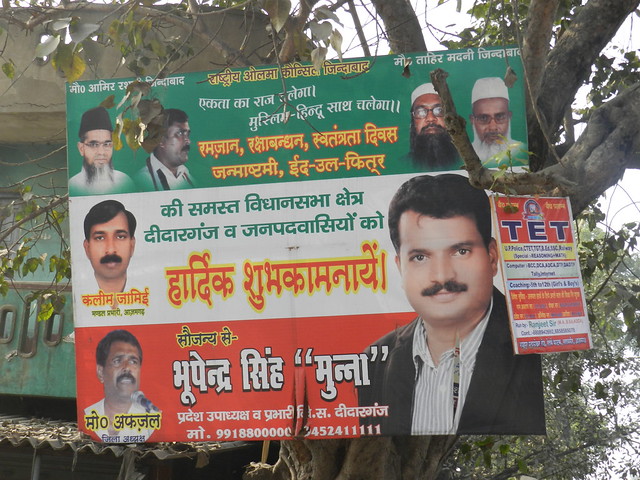By Kashif-ul-Huda, TwoCircles.net
Before every Assembly or Parliamentry election in Uttar Pradesh, there are always lots of activities eyeing the all important “Muslim vote bank.” Whatever may be the reality of this vote bank but none of the Muslim-led political party had much success in UP in the past except of course Muslim Majlis of Dr. Faridi that was able to win some seats in 1960s and 1970s.
History has not prevented Muslims from trying their luck time and again. In the just-concluded UP election a number of political parties were in the fray that can be called as “Muslim-led” parties- Peace Party (PPI), Rashtriya Ulama Council (RUC), Social Democratic Party of India (SDPI), and Welfare Party (WPI). Strong showing in the last Lok Sabha and by-elections by both PPI and RUC added to the excitement.
There were a number of political parties that can fall under the category of Muslim-led party, e.g. Ittehad-e-Millat Council (IMC) of Tauqeer Raza, Qaumi Ekta Dal of Afzal Ansari, National Loktantrik Party of Arshad Khan and old players like Muslim Majlis and three different flavors of Muslim Leauge -Indian Union Muslim (IUML), Muslim League Kerala State Committee, and Akhil Bharatiya Muslim League (Secular).

RUC candidate Bhupendra Singh came third in Didarganj constituency polling 34,174 votes. His was the best performance for the Council. [TCN Photo]
Peace Party won four seats; three of those returned Muslim candidates. Qaumi Ekta Dal won two seats and IMC won one seat in this election. Rashtriya Ulama Council (RUC) drew a blank with none of their 63 candidates with any fighting chance.
Rashtriya Ulama Council (RUC) with a clearly identifiable Muslim name and Muslim religious leadership and Peace Party of India (PPI) with an English name and headed by a famous surgeon and businessman Dr. Ayub present a contrasting image of a “Muslim party.” I decided to dig deep into the election results of these two parties not only because of their different entry points into politics but also because they put up a large number of candidates making a data analysis worthwhile exercise.
Candidates
RUC put up 63 candidates of which 26 (41%) were Muslims while 37 (59%) were non-Muslims. 61 (29%) of the 208 PPI candidates were Muslims while 147 non-Muslims candidates made up 71% of their candidates. It is quite surprising that even those parties that are labeled as “Muslim parties” have given majority of their tickets to non-Muslim candidates. In fact presence of non-Muslim candidates is common to almost all parties such as SDPI, WPI, IMC, and even Muslim League. This suggests that leaderships of these parties are aware of the political dynamics of India and that their growth is not possible by appealing to just Muslim voters. This is visible in their campaign as well, where the language is secular and political rather than Islamic or religious in nature even when appealing to Muslim voters.
Votes
Spectacular failure of the RUC resulted in their 63 candidates polling only 154884 votes which gives them 0.21% share of the total votes polled in UP 2012 elections. Peace Party put up three times more candidates than RUC which helped it poll 1784861 votes or 2.4% of the total votes, a respectable number.
But it is not just the increased number of candidates that helped PPI but rather their candidates performed much better than RUC. On an average they polled in over 8500 votes while RUC candidates could barely manage 2500 votes/candidate.
Another interesting revelation is that though 41% of RUC candidates were Muslims when it comes to votes polled, only 30% of total RUC votes went into their Muslim candidate accounts. Muslims, that were 29% of PPI candidates, polled 27.5% of total PPI votes.
Conclusion
“Muslim political parties” were Muslims only when it came to their top leadership otherwise their campaign, candidates, and strategy was no different than other parties though they may have issued more statements on Muslim-centric issues. They didn’t hesitate in giving tickets to non-Muslims and these candidates didn’t disappoint their parties either. Having a non-Muslim candidate added on average as much as 760 (for PPI) to 1140 votes (for RUC) per ticket. But if one considers position of the candidate in the final tally for each constituency then non-Muslim candidate didn’t perform any better than Muslim candidates. Frequency distribution plot of positions for Muslims and non-Muslim candidates follow similar path for both parties.
An election that returned 68 Muslims to the UP assembly, a record when it comes to Muslim political representation in the state, also showed a mixed result when it comes to the Muslim-political party experiment. The increase in the number of Muslim-led party clearly shows the disenchantment with the major political parties. If national and regional parties fail to take anything more than symbolic steps for Muslims then this experiment will continue to grow and may even yield results.
